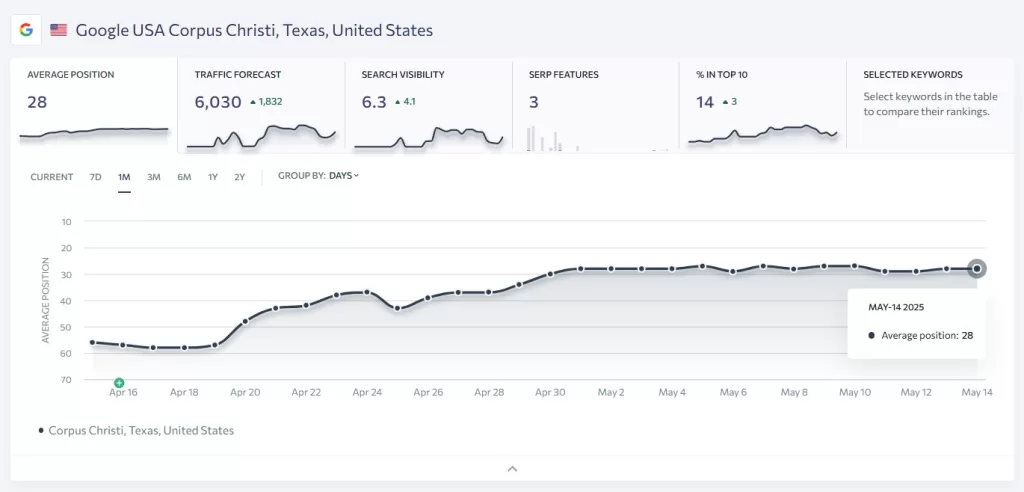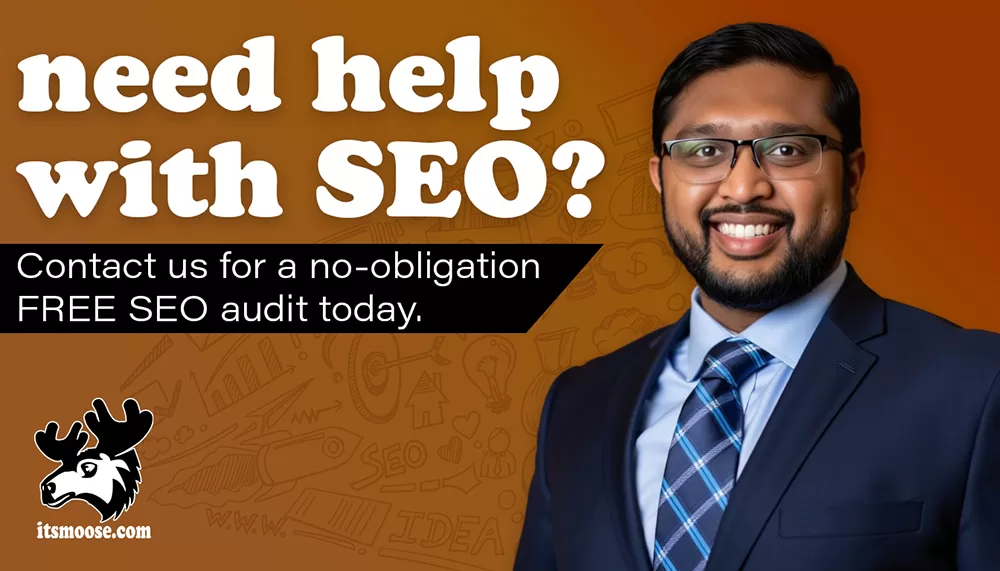Search engines shape online visibility, serving as gatekeepers to the vast continuously-growing internet as you know it. Search Engine Optimization, or SEO, is a critical tool in digital marketing. SEO is used in digital marketing with proper marketing strategies to ensure businesses reach their target audience and potential customers.
SEO plays a vital role in enhancing Google search results and building credibility. It improves user experience and drives organic traffic without extra costs. Unlike paid search, social media, or email marketing, SEO focuses on long-term results.
ItsMoose.com breaks down how SEO is used in digital marketing, contrasting it with other marketing strategies. We’ll dive into the core of search strategy and advanced SEO techniques to examines its impact on ROI. After reading this article, you’ll come to the conclusion that that SEO needs to be a part of your digital marketing strategy plan. It’s important to know how to incorporate SEO in Corpus Christi with your business.
Introduction to SEO in Digital Marketing
SEO, or Search Engine Optimization, enhances a website’s visibility on search engines. It improves search engine rankings. Businesses boost organic traffic with the right SEO techniques that make sense for their business.
An SEO marketing strategy is essential for your digital marketing efforts. It increases the impact on search rankings and attracts a target audience. A strong SEO strategy aligns with search intent and search term relevance.
Even digital marketing agencies like ItsMoose.com rely on SEO optimization. Our digital marketing services aim for improving online presence. We optimize for search engine crawlers and algorithms.
While it’s considered that there are four types of SEO, the two main types are:
- On-page SEO: Focuses on content optimization and relevant keywords.
- Off-page SEO: Involves activities like backlink building.
SEO involves creating high-quality, relevant content. Content quality impacts user intent and search query satisfaction. If you create high-quality, valuable content, it will have a positive impact on search rankings. Search algorithm updates prioritize user experience and the type of content on pages. Businesses must avoid duplicate content and any low-quality piece of content.
Consider this table outlining vital aspects:
| SEO Aspect | Focus Area |
|---|---|
| On-page SEO | Content, keywords, user intent |
| Off-page SEO | Authoritative backlinks, domain authority |
| Content Marketing | High-quality, relevant content |
Corpus Christi businesses leverage SEO to enhance digital marketing strategies. They improve search engine rankings through consistent efforts. The benefits of SEO tie to key business goals; increasing brand awareness and leading to higher sales and revenue.
SEO in Digital Marketing Case Study: Birdwell AC & Heating
A perfect example of all four SEO types working together produces favorable results. In the case of Birdwell AC & Heating, within a month we were able to accomplish several SEO goals (see screenshot below).
We increased the average positions for all 63 keywords from 58 to 28. 14 of those keywords share ranking of search queries in the top 10%. We also improved their traffic forcast and search visibility.

How SEO Is Used In Digital Marketing
SEO serves as a cornerstone in digital marketing. It focuses on enhancing website presence in search results and major search engines. By optimizing content, websites increase their reputation with search engines. This leads to increased visibility and website traffic from search engines.
The goal for businesses in Corpus Chrisit is to boost their credibility and authority online. So, SEO is crucial for building brand reputation. It encourages visitor trust and engagement. By providing informative content for SEO, companies improve their visibility on search results pages. Thus, organic traffic increases, leading to campaign success. SEO is integral to driving online customer engagement. Therefore, it is essential for a strategy’s overall success.
Enhancing Website Visibility
SEO enhances website visibility by improving search rankings. This will increase if your site builds a credible reputation with search engines. A boost in search engine rankings increases click-through rates and organic traffic. With high-quality content, the website’s presence strengthens.
SEO and web design focus on user experience. By optimizing on-page and off-page technical elements, visibility increases. Technical optimization boosts organic visibility too. Semantic markup can enhance search results. It displays rich snippets like review stars. Images attract more clicks. Ultimately, enhanced visibility leads to greater organic traffic.
Building Credibility and Trust
Higher search rankings enhance a website’s authority. Busineses need to portray themselves as reliable and have credibility. A part of the core of SEO lies with helping increase brand reputation. Websites with higher rankings appear more credible.
This is where setting up a Google Business profile comes in. Adding your company to multiple reputable business listings encourages users to engage and share the brand. Optimizing your Google Business profile is a specific key aspect of SEO and building customer loyalty. Managing online reviews and ratings builds sustainable trust with your target audience. The impact of Google Reviews on SEO shapes your long-term credibility.
Strategic SEO efforts establish an authoritative online presence. It attracts target audiences. SEO aligns with search engine credibility metrics. Users perceive high-ranking websites as trusted and reliable. This perception is vital for attracting visitors. Credibility achieved through SEO contributes to successful digital strategies. It ultimately strengthens brand loyalty.
Burger King Reviews: Sometimes You Can’t Have It Your Way
The restaurant industry relies heavily on managing their online presence and ratings for increasing their revenue. If you take a look at the Google reviews of Burger King in Corpus Christi, Texas (on Saratoga Blvd), you’ll notice that there’s room for improvement. A less than average rating may impact a user’s decision to dine at or order food from an establishment.
Improving User Experience
SEO optimizes a website’s structure and navigation. This improves user experience significantly. Visitors can access information more easily. Optimized site architecture allows seamless page transitions. Faster load times enhance interaction quality. Users experience fewer delays. High-quality content boosts readability. It encourages actions like subscribing or buying. SEO employs techniques like descriptive URLs.
These improve user experience intuitively. Schema markup further enriches information display. A better user experience fosters engagement. This can lead to increased conversions. Implementing SEO therefore results in significant benefits for user satisfaction.
Increasing Organic Traffic
SEO strategies boost visibility on search results pages. This is crucial for increasing organic traffic. Organic SEO drives more traffic than social media alone. This highlights its importance in user attraction. Increased organic traffic indicates effective SEO efforts. It contributes to digital marketing’s overall reach. Semantic markup can enhance click-through rates. This increases organic traffic to the website. SEO builds credibility and trust. More potential users visit reputable sites as a result. Increased organic traffic ultimately signifies campaign success. Hence, integrating SEO is vital for marketing strategies.
SEO vs. Other Digital Marketing Tactics
SEO enhances organic search visibility, unlike paid tactics with services like Google Ads. Search engine optimization optimizes website content, leading to higher rankings on search engine results pages (SERPs). These results boost business credibility and develop a competitive advantage. SEO builds strong domain authority and user trust. On the other hand, pay-per-click (PPC) ads offer instant visibility. However, PPC relies on continuous investment, contrasting SEO’s long-term benefits. Social media marketing engages users directly. Yet, SEO structures content for search engines, enhancing accessibility. A good SEO strategy increases organic traffic and brand reputation. While email marketing focuses on personalized messaging, SEO ensures a lasting online presence.
SEO vs. Paid Search (PPC)
SEO improves a website’s organic search rankings by optimizing content quality and keyword relevance. In contrast, PPC involves bidding on keywords for paid advertisements. SEO doesn’t require direct payments for search listings, unlike PPC, which charges per click. SEO contributes to long-term growth and often needs a lower budget than PPC. PPC provides immediate visibility but requires ongoing investment. SEO and PPC form parts of search engine marketing (SEM), maximizing a business’s reach. A digital marketing strategy often integrates both, using their strengths for growth. This combination boosts return on investment effectively.
SEO vs. Social Media Marketing
SEO focuses on enhancing website content for better organic search rankings. On the other hand, social media marketing aids networking and link building in search engine optimization. Effective SEO strategies take time to show significant results. Social media campaigns yield faster engagement metrics but depend on platform algorithms. SEO drives organic traffic growth by addressing user intent. Social media marketing relies more on audience interaction. Both can support digital marketing goals by driving leads. They can enhance conversions when integrated into a cohesive strategy. By leveraging both, businesses maximize their outreach and effectiveness.
SEO vs. Email Marketing
SEO and email marketing differ in their approaches within digital marketing. Search engine optimization focuses on optimizing a website’s content for better search engine visibility. Meanwhile, email marketing uses personalized messaging to engage directly with users. SEO enhances organic website traffic over time by improving search rankings. Email marketing, however, relies on direct communication and immediate engagement. While SEO structures content to match search intent, email marketing builds user relationships. Combining SEO and email marketing can strengthen a digital marketing plan. Each contributes uniquely to a business’s growth and user engagement strategy.
Core SEO Strategies
Search Engine Optimization (SEO) is essential for digital marketing. It enhances a site’s visibility on Search Engine Results Pages (SERPs). SEO strategies ensure content effectively addresses user queries. Optimized assets like web pages and blogs play a crucial role. Three core strategies include On-page SEO, Off-page SEO, and Technical SEO. Both companies and agencies tailor these strategies to improve search engine rankings. The goal is to meet user intent and improve organic search traffic. Implementing these strategies requires an understanding of search engine algorithms and search intent. These techniques boost online presence and increase visibility on search engines.
On-Page SEO Techniques
On-page SEO enhances individual web pages for better search engine ranking. It ensures content is structured and informative. Key elements include optimizing page titles, meta descriptions, and URLs. Alt texts, images, and internal links also play significant roles. Effective on-page SEO aligns with relevant keywords and satisfies searcher intent. Thorough keyword research is crucial to meet user goals. The focus is on producing relevant content that is easy to understand. Quality content boosts organic search traffic and meets audience needs. Websites must offer authoritative information tailored to their industry.
Off-Page SEO Approaches
Off-page SEO focuses on external link optimization strategies and content management. Building backlinks increases a site’s authority and credibility. Simply put, backlinking involves acquiring links from external websites that point to your own. Building authoritative backlinks signals to search engines that your content is valuable and authoritative.
Some techniques include guest blogging and collaboration with other sites. Blog posts should have content that prospective customers are looking for.
Backlinks indicate to search engines that a site is valuable. These tactics enhance online presence and improve rankings. By getting high-quality backlinks, your site trustworthiness with increase your SEO ranking. Participation in online communities like Quora bolsters authenticity.
Engaging in social media marketing is also effective. It’s important to have complete profiles on as many reputable social media platforms as possible. Digital PR enhances trust through external endorsements. Partnerships and influencer marketing are valuable tools. A strong off-page strategy complements on-page efforts.
Technical SEO Elements
Technical SEO optimizes a site’s backend for usability. It ensures search engines can crawl and index content easily. Key elements include site speed, mobile-friendliness, and structured data. Ensuring a responsive design is crucial in today’s mobile-first world. Over 60% of website traffic comes from mobile devices. Take a look at some additional statistics in the graphic below. Mobile optimization is a critical component of technical SEO. Title tags and site structure play important roles too. JavaScript rendering must be efficient to improve loading times. Proper technical SEO supports overall search engine rankings. Enhanced usability leads to better online visibility.
Advanced SEO Techniques
SEO techniques constantly evolve to improve website visibility. Technical SEO ensures sites are optimized for search engines. It focuses on site speed, mobile-friendliness, and structured data. On-page SEO optimizes web pages with meta tags, headings, and internal links. These techniques improve rankings and engage the target audience effectively. Off-page SEO enhances credibility by building backlinks through guest blogging, digital PR, and partnerships. This increases the site’s domain authority. The future of SEO emphasizes answering user queries. Optimizing for featured snippets and voice search is crucial. Using Answer Engine Optimization (AEO) leverages these advancements. SEO integration in digital marketing builds long-term brand credibility. It provides a competitive advantage by increasing organic traffic and improving user experience.
Local SEO for Geographical Targeting
And don’t forget the relationship between local SEO and Google Maps. Having a Google Business profile is essential for local SEO. It helps businesses be found quickly by nearby users. Local SEO enables small businesses to compete locally, not globally. Optimizing for mobile use is crucial. Most searches happen on mobile devices. Local directory listings are vital for local SEO. They ensure business visibility on platforms like Yelp. Local SEO helps target geographical audiences effectively. It ensures your business appears in relevant local searches.
Local SEO is important because it focuses on improving search results in specific areas. It uses local keywords and consistent contact information. For example, ItsMoose.com frequently uses the term “digital marketing in Corpus Christi, Texas” in website content. Obtaining local citations enhances local visibility.
Take a look at the screenshot and example for Lead Industrial Staffing. ItsMoose.com built a separate website to rank locally in Corpus Christi and the Coastal Bend area. It’s a perfect example of how local SEO will beat national “corporate” websites with multiple location pages.
Mobile SEO for User Accessibility
Mobile SEO is critical as more searches occur on mobile devices. All web design needs to be mobile-first. Mobile-first indexing means Google favors mobile-friendly websites. Many businesses forget that mobile SEO and websites go hand-in-hand, due to usage surging over the years.Quick load times improve user accessibility and search rankings. Ensuring easy navigation enhances user experience. Technical SEO targets user experience on mobile devices. A mobile-optimized site should be user-friendly. Information should be accessible and easy to find on mobile. Enhancing mobile usability boosts search engine rankings. This ensures a positive user experience. Prioritizing mobile SEO benefits digital marketing strategies. It improves online presence and organic traffic.
Voice Search Optimization for SEO in Digital Marketing
Voice search plays an essential role in digital marketing strategies of the future. More consumers are using voice search daily. Optimizing for voice search requires adaptation. It often involves using local SEO tactics. This ensures visibility for local queries. Incorporating voice search optimizes digital marketing strategies. It helps target audience segments doing local “near me” searches. As mobile traffic grows, voice search becomes critical. This integration improves online visibility and engagement. Addressing voice search trends aids in reaching a wider audience. It modernizes SEO strategies in dynamic digital landscapes.
Integration of SEO with Other Marketing Strategies
SEO holds immense importance in digital marketing. It boosts visibility and organic traffic on web pages. It works seamlessly with other strategies for long-term brand equity. Search engine optimization focuses on building trust, credibility, and reputation. Off-page SEO techniques include influencer marketing and backlink creation, enhancing website authority. Optimizing content and technical aspects of a site improves user experience. This optimization leads to higher conversion rates. Additionally, SEO effectively complements pay-per-click and social media marketing. It drives quality leads and maximizes return on investment (ROI).
Content Marketing and SEO
SEO and content marketing go hand in hand. They create high-quality, relevant content for user inquiries. SEO involves web pages, videos, images, and blogs. This approach adds value to user queries. Effective SEO contributes to a brand’s credibility and reputation over time. On-page SEO includes thorough keyword research. This optimizes meta tags, content, and HTML code. Such practices ensure content relevance for the target audience. Off-page techniques like guest blogging increase backlinks. A website’s domain authority and credibility benefit from these efforts. So, increasing organic traffic becomes essential for businesses.
SEO and Conversion Rate Optimization (CRO)
SEO strategies boost website visibility. High search rankings increase website traffic and conversion opportunities. With higher SERP rankings, organic traffic grows. More visitors mean more potential leads. Great usability and accessibility enhance user experience. This plays a vital role in conversion rate improvement. SEO also boosts brand credibility and trust. Users and search engines trust a well-optimized site more. This trust attracts and retains more visitors. By using SEO in digital marketing, businesses gain a competitive edge. Thus, achieving better conversion outcomes becomes possible.
SEO and Influencer Marketing
SEO supports influencer marketing efforts. Insights from SEO improve campaign targeting. They refine keyword usage for influencers. This combination elevates brand visibility. Influencers create content leading to quality backlinks. Such links, a part of off-page SEO, boost online presence. Collaborative efforts enhance a website’s authority. Therefore, validating and amplifying trustworthiness becomes achievable. Influencer marketing links contribute to off-page SEO. They enhance the authority of the targeted site. A new search filter, Search Perspectives, influences influencer marketing. It shifts how content generation and backlinks occur. The potential for enhanced online presence increases.
The Impact of SEO on ROI
SEO plays a crucial role in enhancing ROI through digital marketing strategies. It ensures increased visibility and targeted traffic. This, in turn, improves a business’s ROI. SEO also elevates online credibility and authority, indirectly boosting ROI via trust and user engagement. Integrating SEO fosters long-term brand equity, leading to sustained ROI growth. Insights from SEO optimize PPC campaigns, maximizing ROI in digital marketing. Using both SEO and PPC proves to be complementary. This approach results in a more effective digital marketing strategy. Consequently, businesses experience an improved ROI.
Measuring Success with Analytics
Analytics is vital in tracking SEO success. Organic traffic acts as a key performance indicator in SEO marketing. It measures website visits from non-paid sources. Google Analytics helps in this analysis. Keywords are terms entered into search engines. Tracking keyword rankings helps understand content visibility. Backlinks show how many sites link to your website. Tools like Semrush or Ahrefs analyze these links. Setting SEO objectives aligns strategies with business goals. This ensures successful goal achievement. Notably, SEO leads boast a 14.6% close rate on average, converting traffic into customers.
Long-term Benefits of SEO
SEO offers enduring value by generating organic traffic and leads. This contributes to revenue growth over time. Achieving high-ranking search results through SEO allows sustained lead generation. Maintaining top positions minimizes ongoing costs. SEO builds long-term brand equity. It enhances visibility on search engine results pages. At the top, SEO continues producing traffic without high expenses. It supports other digital marketing strategies too. It complements efforts, like social media and paid advertising. Overall marketing effectiveness improves with SEO. Thus, SEO remains vital for long-term business success.
Adaptation to Technological Advancements
Technology evolves rapidly, affecting SEO strategies. Businesses must adapt to maintain their digital presence. Search engines adjust to how users interact with devices. SEO practices evolve accordingly. A successful digital marketing strategy requires constant updates and adaptation. It accounts for changes in user behavior and search engines. Technical SEO now includes tasks like optimizing for mobile and voice search. Shifting trends demand new SEO tactics. Digital marketing services integrate these updates for effectiveness. The history of SEO shows a shift from simple meta-tags to user experience focus. SEO agencies need to stay current with technology changes. This ensures their clients remain competitive.
Influence of Artificial Intelligence on SEO
AI transforms SEO by improving search algorithm sophistication. AI focuses on understanding user intent and context. Google’s RankBrain algorithm, introduced in 2015, exemplifies this shift. It interprets search queries more effectively. AI-driven tools aid content creation and optimization. Shopify Magic and Jasper are prime examples. These tools help generate SEO-optimized content. AI’s influence leads to more zero-click searches. Users get answers directly, reducing click-through necessity. Search engines emphasize topical authority. Experts produce content showing deep understanding and expertise. AI integration makes SEO more about quality than just keywords.
The Importance of Algorithm Updates
Algorithm updates play a crucial role in SEO. These updates impact search engine rankings significantly. SEO professionals must monitor algorithm changes closely. This practice ensures continued online visibility. Google updates affect keyword matching to focus on intent. RankBrain and BERT improve language understanding. Companies adapt strategies for lasting success. Algorithm changes require ongoing adjustments. This adaptation helps maintain competitive edge. Marketers and businesses benefit from understanding search algorithms. Tracking developments secures high search engine result page (SERP) rankings. SEO companies prioritize algorithm updates in strategies. Continuous learning remains key to effective SEO.
Continuous Learning for SEO in Digital Marketing
Like with any discipline, continuous improvement and updates are required for effective SEO. Algorithm changes require adaptability to maintain search rankings. Practical experience also plays a crucial role. Building personal websites enhances SEO skills effectively. Moreover, hands-on experimentation with various tactics advances expertise in search engine optimization.
Consider the following strategies for continuous learning in SEO:
- Build personal websites.
- Experiment with different SEO tactics.
- Attend specialized SEO courses.
Services by experts at ItsMoose.com also help enhance SEO for local businesses in Corpus Christi and the Coastal Bend. We cover search marketing fundamentals and strategies. SEO needs a multidisciplinary approach as well.
Remember, continuous learning in SEO involves consistent practice and updates. Expanding skill sets ensures effective SEO implementation.





